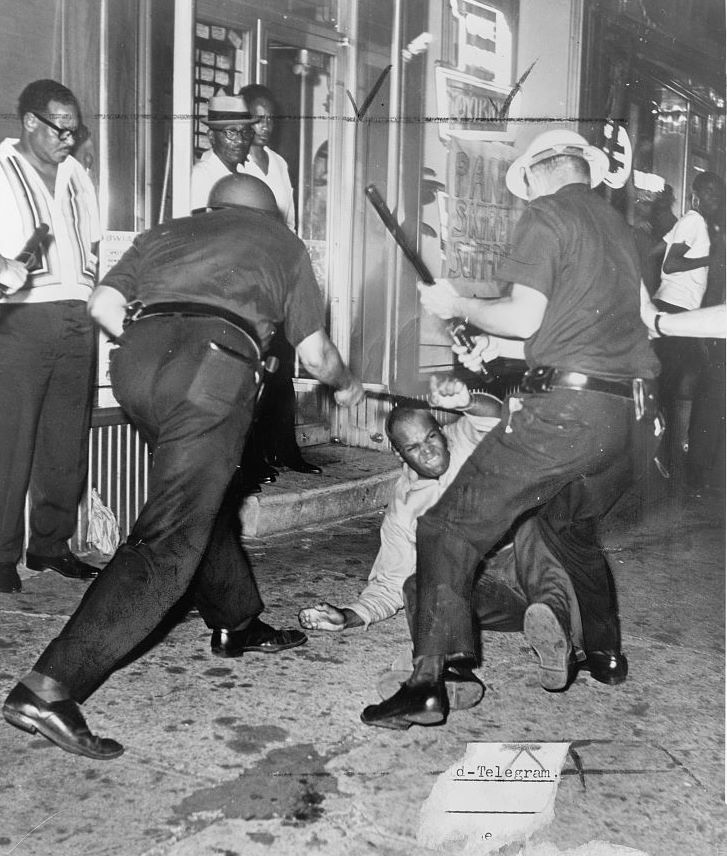The Harlem Riot of 1935 was the first twentieth-century race riot, centered in Harlem, New York. There were many unfavorable conditions imposed on the black community at the time of this riot – conditions such as mass unemployment, frustrating inequality, and police brutality. The incident that sparked the initial outbreak took place on the afternoon of March 19, 1935. Lino Rivera, a black teenager, was caught stealing a pen-knife from a Harlem store on 125th street. The store owner and an employee detained the thief and waited for an officer to arrive at the scene. Meanwhile, a crowd of worried spectators gathered around the store. Rivera was released and escorted out the back of the store, but a few circumstances, such as an ambulance meant to treat the store owner's wounds, and a hearse which was stationed near the scene of the incidents, led spectators to assume that the thief had been killed. Of course, the death of a minor has always stripped people of the ability to keep their emotions in check. The crowd became violent and the rumor of the death of the teenager spread around Harlem, causing the riot.
Friday, November 21, 2014
What Caused the Harlem Riots of 1935?
The Harlem Riot of 1935 was the first twentieth-century race riot, centered in Harlem, New York. There were many unfavorable conditions imposed on the black community at the time of this riot – conditions such as mass unemployment, frustrating inequality, and police brutality. The incident that sparked the initial outbreak took place on the afternoon of March 19, 1935. Lino Rivera, a black teenager, was caught stealing a pen-knife from a Harlem store on 125th street. The store owner and an employee detained the thief and waited for an officer to arrive at the scene. Meanwhile, a crowd of worried spectators gathered around the store. Rivera was released and escorted out the back of the store, but a few circumstances, such as an ambulance meant to treat the store owner's wounds, and a hearse which was stationed near the scene of the incidents, led spectators to assume that the thief had been killed. Of course, the death of a minor has always stripped people of the ability to keep their emotions in check. The crowd became violent and the rumor of the death of the teenager spread around Harlem, causing the riot.
Friday, November 14, 2014
Extra Credit: Taylor and Michael
I have done the extra credit assignment for this week by commenting on Michael's Gorgeous Shell and Destruction of Gotham posts. I have also commented on Taylor Alford's Fourth and Fifth blog posts. Check them out.
A Way with Words
Being that this week I have the opportunity to reflect on
any aspect of F. Scott Fitzgerald’s novella, “May Day”, I would like to take the
chance to share my favorite passage in the narrative, and explain why it
pleased me to the extent that I am now shedding some light on it. The passage
appears on page 39.
“She thought of her own appearance. Her bare arms and
shoulders were powdered to creamy white. She knew they looked very soft and
would gleam like milk against the black backs that were to silhouette them
tonight. The hairdressing had been a success; her reddish mass of hair was
piled and crushed and creased to an arrogant marvel of mobile curves. Her lips
were finely made of deep carmine; the irises of her were delicate, breakable
blue like china eyes. She was a complete, infinitely delicate, quite perfect
thing of beauty, flowing in an even line from a complex coiffure to two small
slim feet.”
This passage is a stunning description of the novella’s main
female character, Edith. The author is able to slow down time, in this description;
he is able to romanticize the woman’s shoulders, her small figure, her
ginger-colored strands of hair, her red lips and delicate eyes. For a moment,
it is almost as if the setting fades into nothingness, and the only thing that
matters is this mistress of the Gamma Psi dance. I believe that the combination
of Fitzgerald’s attention to detail and his descriptive abilities make this
passage a very strong and beautiful moment in the narrative, and it also makes
the reader gain an appreciation to Edith’s character.
Tuesday, November 11, 2014
Assignment #6
For my sixth blog assignment, I have visited and left comments on the two most interesting blog posts that I came across --the blogs of other students from Violence Art Culture. I went through many blogs, but Jeelyan Martinez's post, "Violence in the Novel" and Marcela Romero's post, "A Potential Theme in Caesar's Column" were very strong and interesting ideas. I showed my interest by leaving comments in which I told them why I found their ideas interesting, and I also left them a few minor suggestions.
Subscribe to:
Posts (Atom)

